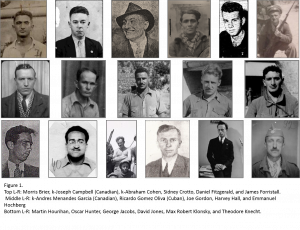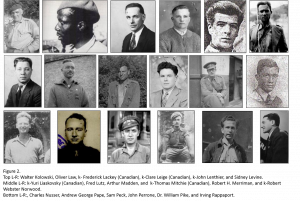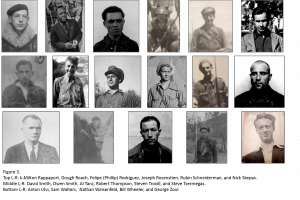Jarama Series: Pingarrón
In the Jarama Series, The Volunteer Blog will present a series of articles examining the experiences of volunteers in the Abraham Lincoln Battalion from its formation to the Brunete Offensive in July 1937. Articles will focus both on the battalion’s formation as well as on the individuals who served. These articles are intended to provide the reader with a better appreciation of the men and women who made up the first American combat formation in Spain.
Jarama Series: Pingarrón
After making its first attack on February 23, 1937, the Abraham Lincoln Battalion continued to take casualties in the days leading up to their next assault. Despite reorganizing and receiving reinforcements, they were ill-prepared for their next battle. On February 27, 1937, the attack on Pingarrón left the Lincoln Battalion as a hollow shell.
A Rude Awakening
On February 24, Jack Lenoris and George Jacobs woke up in no-man’s-land about 30 yards from the enemy trenches they charged the previous night. They lay huddled behind a small tree in a depression that they scraped out during the night. The two somehow missed the order to retire. Shortly after dawn they realized that they were all alone and exposed. Recognizing that they needed to fall back, they crawled and made short dashes between cover, slowly making their way toward friendly lines. Nationalist riflemen and machine gunners fired at them whenever they showed themselves. Alerted by the Nationalist fire, the remainder of the Lincolns attempted to provide covering fire. Despite their best efforts, Lenoris was cut down by machine gun fire. Jacobs eventually made it back, sprinting the last fifty yards and jumping into the trench. Exhausted and wearing a uniform tattered by bullets, Jacobs was sent to the rear.[i]
Snipers
Nationalist snipers continued to take their toll on the Americans. After assisting with the evacuation of Company One Commander John Scott the night before, Joe Gordon, was hit by a sniper during the morning of February 24. He was blinded in one eye and evacuated to a hospital. Other soldiers were less fortunate.[ii]
Later that morning the cookhouse sent up tubs of coffee to the front lines. Robert Webster Norwood, a 27-year old volunteer from Maine, dipped his cup in and stood up. “Come on boys, dig in. I’ve got mine” he said. “This is my last cup.” Moments later a sniper’s bullet pitched him face first into the coffee.[iii] A sniper claimed Alonzo Watson the Quartermaster for Company One the following day. Watson was hit crossing a section of paved road that that intersected the trench line. The waist-high wall of sandbags constructed on the road provided insufficient protection. Watson, a WWI veteran, was the first African American volunteer to die in Spain.[iv]
Reorganization
The Battalion leadership required reorganization after the assault on February 23. Stephen Daduk the Battalion Adjutant “cracked up” and was sent to a hospital.[v] Merriman shifted Douglas Seacord from command of the Machine Gun Company into the Adjutant slot. The Connolly Column’s William Henry, who assumed command when John Scott was killed, was confirmed as Commander of Company One. John (Eamon) McGrotty was appointed as Company One Adjutant.[vi] Andrew Royce continued to command Company Two with Sidney Levine as his Adjutant.[vii] The Machine Gun Company was under the command of another Irish volunteer William James Tumilson.[viii]
Reinforcements
Seventy-three, rudimentarily trained reinforcements arrived on February 26. The reinforcements included Sidney Levine, Robert Klonsky, Charles Nusser and John Lenthier.[ix] Having arrived in Spain no more than two week earlier those who survived learned to be soldiers through on-the-job training and mentoring by earlier volunteers. Years later, Charlie Nusser, who volunteered at the VALB office, noted that he only fired three rounds through his rifle before going into combat. He jokingly accused Moishe Brier, one of the first volunteers and fellow VALB office volunteer, of being “overtrained.” Brier along with the first group of Lincolns had fired five rounds into a hillside before reaching the Jarama Front.[x]
The Plan
Lieutenant Colonel Vladimir Copic the commander of the XVth Brigade brought his battalion commanders together before dawn on February 27, to brief the plan to take Pinigarrón and drive the Nationalists back across the Jarama River. The attack would begin at 7 AM with an aerial bombardment and strafing of the enemy trenches. An artillery bombardment would begin when the aircraft departed. These actions would pin down the enemy. Tanks would then lead the assault providing covering fire and crushing the wire. The 24th Spanish Brigade would leave its trenches and begin advancing. Once the Spanish troops reached the Lincoln’s front line they would leave their trenches. The Spanish were to provide flank support for the Americans who would push forward and capture the enemy trenches. Republican reserves would consolidate and secure the heights of Pingarrón.[xi] Merriman believed the plan was sound based on the briefing and was a “good use of all arms.”[xii]
Disaster
The plan began to unravel from the beginning. Bad weather pushed the start time to 10 AM. Merriman recalled that the artillery started at “9:50 and the 24th Brigade started to go forward” probably encouraged by the appearance of two tanks that fired a few rounds before pulling back. The 24th Brigade took heavy casualties and fell back to their trenches.”[xiii] The Lincolns initiated a firefight with the opposing trenches to provide covering fire for the 24th Brigade. The volume of Nationalist return fire suppressed the Lincolns.
Merriman called Brigade Headquarters and asked where the promised air and tank support was. Copic gave “vague responses” suggesting the attack was delayed. He then asked if the Lincolns had deployed an aviation signal. Merriman was instructed to put out a signal on the nearby road.[xiv] Two men volunteered to emplace the signal. Joseph Streisand and Robert Pick dashed into the road and laid out the signal a large T pointing toward the enemy lines. They were cut down by machine gun fire before they could return to the safety of the trenches.[xv]
Copic called the Lincolns to ask why they had not advanced. He told Merriman that the 24th Brigade had passed the Lincolns and required support. Merriman could clearly see that the 24th were still in their trenches and told him so. Copic ordered Merriman to begin the assault. Merriman prepared to lead the attack in person. Two brigade staff officers arrived at that moment with order to remove Merriman from command if he failed to order the attack.[xvi]
Merriman blew a whistle and clambered out of the trench followed by his men. It was approximately 12 noon. Just steps out of the trench, he was smashed backward by a bullet and pulled back into the trench. Merriman whose shoulder was broken in five places told a runner to inform Seacord that he was now in charge. Seacord was already dead along with many other volunteers caught in no-man’s-land by the enemy machine gunners.[xvii]
The Lincolns were too green to realize they should have taken cover or retreated. Section leader Robert Taylor recalled seeing the crisscrossing tracers from Nationalist machine gun’s interlocking fire and watching volunteers being cut down as they advanced unknowingly into the stream of bullets. Lincolns wounded and dead from the first company, covered the battlefield. The second company left the trenches and met the same fire. Survivors soon realized that further advance was impossible and men took whatever cover they could find. Dutch stretcher bearers who attempted to help the wounded were shot down.[xviii] Some of the new recruits went over the top carrying their packs. One, John Lenthier an actor from Boston, was shot down and lay “like a turtle” as he bled out.[xix]
A rain shower in mid-afternoon probably saved many lives as the Nationalist snipers had trouble identifying additional targets. Eventually darkness fell and survivors, including the wounded who were able to move, climbed back into the trenches. Survivors began to venture out into no-man’s-land to look for wounded. The dead remained in the field. The dead would be recovered over the next few weeks. The body of Milton Rappaport was never recovered. He was reported to have been the only volunteer to reach the enemy wire.[xx]
On the morning of February 27 the Lincolns numbered 263 men. The following morning only about 150 were still in the trenches. Most of the Lincoln’s command staff was among the dead and wounded. David Jones who started the day on February 27 as a commissar became the acting battalion commander during the battle. When notified of his battlefield promotion he exclaimed, “I don’t know about military things a f**k.” Jones was fortunate that the Nationalist did not launch a counter attack because he was hard pressed to man his section of the trench.[xxi]
Killed
(1)
Lenoris. Jack. February 24
Norwood, Robert Webster. February 24
(2)
Hansen, Harald Werenskjold. February 25
Watson, Alonzo. February 25
(56)
Arnold, Sidney Milton. February 27
Barale, Louis. February 27 (alt April 24 Morate de Tajuña)
Burdick, Milton. February 27
Campbell, Joseph. Canadian, February 27
Carlson, Carl Joseph. February 27
Chapoff, Samuel. February 27 (28)
Cohen, Abraham. February 27
Cohen, Abraham. February 27
Cohen, Bernard. February 27
Garcia, Andres Menandes. Canadian, February 27
Granzio Robles, Emilio. Cuban, February 27
Guijarros, Carlos. Cuban, February 27
Haskell, Daniel Irving. February 27
Hathaway, William. February 27
Jelin, Maurice. February 27
Juirdana, John. February 27
Kunz, John. February 27
Lackey, Frederick D. Canadian, February 27
Ladman, Louis. February 27
Liaskovsky Yuri (George). Canadian, February 27
Leige, Clare (Clair, Leige). Canadian, February 27
Lenthier, John. February 27
Lenway, Clyde. February 27
Leppo, Ernest Carl. February 27
Liaskovsky, Yury. Canadian of Ukrainian descent, February 27 (?)
Mantell, Benjamin Martin. February 27
Marinoff, Nicholas. Canadian, February 27
Martinez, Emil. February 27
McGroty, Eamon. Irish, February 27
Milijkovic, Jure. Canadian of Croatian descent, February 27 (Lincoln?)
Mitchie, Thomas W. (Michie), Canadian, February 27 (Possibly Lost Trucks) MIA
Morris, Arthur Walter. Canadian, February 27 (February 21)
Morris, Arthur Walter. Canadian, served with Irish, February 27
Navarro Cornejo, Aquilino. Cuban, February 27
Niepold, Paul. February 27
O’Brien, Thomas T. Irish, February 27
Pappas, Philip. February 27
Pekow, Milton. February 27
Perez, Carmelo Ramon. February 27
Pick, Robert Carl. February 27
Rappaport, Milton Mordecai. February 27
Romani, Angelo Christo. February 27 (With the Lincolns ?)
Rosenthal, Julius. February 27
Rufo, Ángel. Cuban, February 27
Russell, Michael. Canadian, February 27 (28)
Schwecke, Arthur. February 27
Schwecke, Hellmath F. February 27
Seacord, Douglas. February 27
Shapiro, David. February 27
Soich, George. February 27
Steiner, Emil Karl. February 27
Streisand, Joseph. February 27
Tieger, Rudolph. February 27
Tseronis, John. February 27
Witt, Arthur Williams. February 27
Missing in Action
(1)
Blaser, Emil Micky, Irish American, February MIA
Wounded in Action
(16)
Beattie, Henry Scott. Canadian, WIA February 27
Fennelly, William. Irish, WIA February 27
Gómez Oliva; Ricardo. Cuban, WIA February 27
Hunt, John. Irish, WIA February 27
McElroy, Patrick J. Irish, WIA February 27
McGrotty, Eamon. Irish, WIA February 27
Merriman, Robert H. WIA February 27
Reinleb, Hyman. WIA February 27
Rodríguez, Lorenzo. Cuban, WIA Jarama February 27
Ryan, Lawrence K. Canadian, WIA February 27
Schneiderman, Rubin. WIA February 27
Smith, Dave. WIA February 27
Smith, Levin Smith, Jr. WIA February 27
Wallach, Harry. WIA February 27?
Lysetz, Hryhorii. Canadian of Ukrainian descent, WIA February 27 Lincolns???
Wheeler, William J. WIA February 27
(1)
Stanley, Patrick. Irish, WIA February Jarama
(13)
Anceaume y Ramos, Alejandro. Cuban, WIA Jarama no date
Cox, Patrick John Colum. Irish, WIA Jarama
Gamiz y Cabrera, Domingo. Cuban, WIA Tentative Jarama no date
González Carrea, Armando. Cuban, WIA Jarama no date
Hedley, Jack. English (served with Irish), WIA Jarama
Hernández Rodríguez, Óscar. Cuban, WIA Jarama no date
Hernández y Valor, Juan Antonio. Cuban, WIA no date
Madurga, Fernando Oliva. Cuban, WIA Jarama no date
O’Flaherty, Francis Patrick. WIA Jarama
Paula Bolaños, Eladio. Cuban, WIA Jarama no date
Rivas y Betancort, Daniel. Cuban, WIA Jarama no date
Rivero Villanueva, Luis. Cuban, WIA Jarama no date
Solis Mesa, Alberto. Cuban WIA, Jarama no date
Sources
Carroll, Peter N. The Odyssey of the Abraham Lincoln Brigade, Stanford, California: Stanford University Press, 1994.
Eby, Cecil. Comrades and Commissars, The Lincoln Battalion in the Spanish Civil War, University of Pennsylvania: University Park, Pennsylvania: 2007.
Landis, Arthur. The Lincoln Brigade, New York: Citadel, 1968.
Merriman, Marion and Warren Letrude, American Commander in Spain, Robert Hale Merriman and the Abraham Lincoln Brigade, University of Nevada Press: Reno, Nevada, 1986.
Rolfe, Edwin. The Lincoln Battalion, New York: Stratford Press, 1939.
Tisa, John. Recalling the Good Fight, An Autobiography of the Spanish Civil War; Massachusetts: Bergin and Garvey Publishers, 1985.
Archives
Russian State Archive of Socio-Political History (RGASPI) ((Российский государственный архив социально-политической истории (РГАСПИ)); Records of the International Brigades (Comintern Archives, Fond 545)
Lincoln Rosters, undated, RGASPI Fond 545, Opis 6, Delo 47, ll. 1, International Brigade – 17 Battalion – Lincoln Men Arrived February 5, 1937; ll. 3-4, Roster of the Lincoln Brigade, undated; ll. 5-6, International Brigade (Lincoln), undated; and ll. 7, 18/2 1937.
Missing Probably Dead (Complete to September 10, 1937), RGASPI Fond 545, Opis 6, Delo 51, ll. 11.
Sandor Voros Collection, Spanish Civil War Collection, Adelphi University Archives and Special Collections, Garden City, NY. [Special thanks for the invaluable research assistance by Bianca LaVeglia.]
[i] Edwin Rolfe, The Lincoln Battalion, (New York, Stratford Press, 1939), 51-52.; and John Tisa, Recalling the Good Fight, An Autobiography of the Spanish Civil War; (Massachusetts: Bergin and Garvey Publishers, 1985), 44.
[ii] Joe Gordon returned to the Lincoln Machine gun Company and fought at Brunete. He was repatriated but elected to return to Spain in the Spring of 1938.
[iii] John Tisa, Recalling the Good Fight, An Autobiography of the Spanish Civil War; (Massachusetts: Bergin and Garvey Publishers, 1985), 45.
[iv] Arthur Landis, The Lincoln Brigade, 77.; Company No. 1, H. Q. Staff, undated, Sandor Voros Spanish Civil War Collection, Series 2, The XVth International Brigade Records, Box 3, Folder 31, Adelphi University Archives and Special Collections, Garden City, NY
[v] Marion Merriman and Warren Letrude. American Commander in Spain, Robert Hale Merriman and the Abraham Lincoln Brigade, Reno, Nevada: University of Nevada Press, 1986), 106.
[vi] Arthur Landis, The Lincoln Brigade, (New York: Citadel, 1968), 72.
[vii] Lincoln Battalion Co. 2, undated, Sandor Voros Spanish Civil War Collection, Series 2, The XVth International Brigade Records, Box 3, Folder 30, Adelphi University Archives and Special Collections, Garden City, NY; Eugene Morse and Martin Hourihan have also been listed as company commanders for Co. 2.
[viii] Lincoln Battalion Officers, undated, Sandor Voros Spanish Civil War Collection, Series 2, The XVth International Brigade Records, Box 3, Folder 30, Adelphi University Archives and Special Collections, Garden City, NY
[ix] Landis, The Lincoln Brigade, 77.
[x] Charles Nusser conversation with the author.
[xi] Cecil Eby, Comrades and Commissars, The Lincoln Battalion in the Spanish Civil War, (University Park, Pennsylvania: University of Pennsylvania, 2007), 70.
[xii] Merriman, American Commander in Spain, 106.
[xiii] IBID. 107.
[xiv] IBID.
[xv] Landis, The Lincoln Brigade, 80-81; and Eby, Comrades and Commissars, 72.
[xvi] Eby, Comrades and Commissars, 72-73.
[xvii] IBID, 74.
[xviii] IBID, 76-77.
[xix] Peter N. Carroll. The Odyssey of the Abraham Lincoln Brigade, (Stanford, California: Stanford University Press, 1994) 101.
[xx] Tisa, Recalling the Good Fight, 47-53; Landis, The Lincoln Brigade, 78-86.
[xxi] Carroll, The Odyssey of the Abraham Lincoln Brigade, 101-102.















